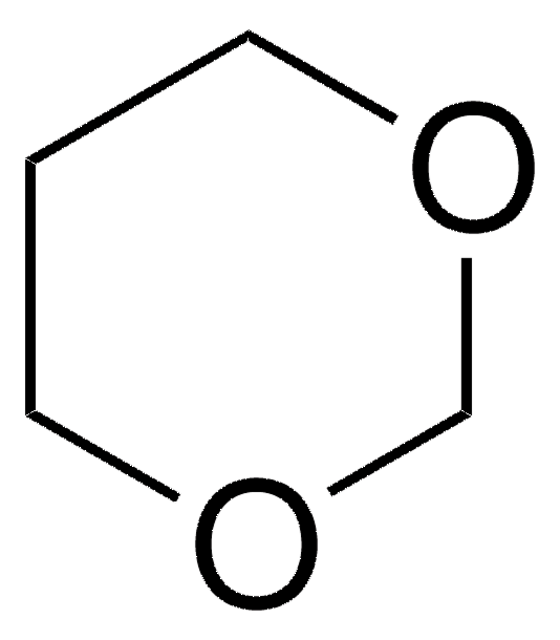676934
1,4-Dioxane
ACS reagent, ≥99.0%
Synonyme(s) :
Dioxane, Oxyde de diéthylène
About This Item
40 mmHg ( 25 °C)
Produits recommandés
Qualité
ACS reagent
Niveau de qualité
Densité de vapeur
3 (vs air)
Pression de vapeur
27 mmHg ( 20 °C)
40 mmHg ( 25 °C)
Essai
≥99.0%
Forme
liquid
Température d'inflammation spontanée
356 °F
Limite d'explosivité
22 %
Technique(s)
thin layer chromatography (TLC): suitable
Impuretés
≤0.0016 meq/g Titr. acid
≤0.005% Peroxide as (H2O2)
≤0.01% Carbonyl (as HCHO)
≤0.05% water
Résidus d'évap.
≤0.005%
Couleur
APHA: ≤20
Indice de réfraction
n20/D 1.422 (lit.)
pH
6.0-8 (20 °C, 500 g/L)
pb
100-102 °C (lit.)
Pf
10-12 °C (lit.)
Température de transition
freezing point ≥11.0
Densité
1.034 g/mL at 25 °C (lit.)
Chaîne SMILES
C1COCCO1
InChI
1S/C4H8O2/c1-2-6-4-3-5-1/h1-4H2
Clé InChI
RYHBNJHYFVUHQT-UHFFFAOYSA-N
Vous recherchez des produits similaires ? Visite Guide de comparaison des produits
Catégories apparentées
Description générale
Application
Mention d'avertissement
Danger
Mentions de danger
Conseils de prudence
Classification des risques
Carc. 1B - Eye Irrit. 2 - Flam. Liq. 2 - STOT SE 3
Organes cibles
Respiratory system
Risques supp
Code de la classe de stockage
3 - Flammable liquids
Classe de danger pour l'eau (WGK)
WGK 3
Point d'éclair (°F)
51.8 °F - closed cup
Point d'éclair (°C)
11 °C - closed cup
Faites votre choix parmi les versions les plus récentes :
Déjà en possession de ce produit ?
Retrouvez la documentation relative aux produits que vous avez récemment achetés dans la Bibliothèque de documents.
Les clients ont également consulté
Notre équipe de scientifiques dispose d'une expérience dans tous les secteurs de la recherche, notamment en sciences de la vie, science des matériaux, synthèse chimique, chromatographie, analyse et dans de nombreux autres domaines..
Contacter notre Service technique









